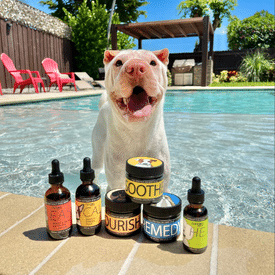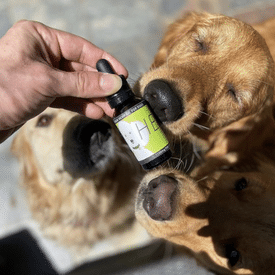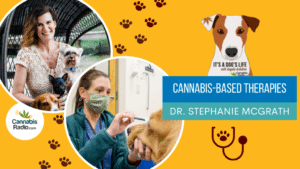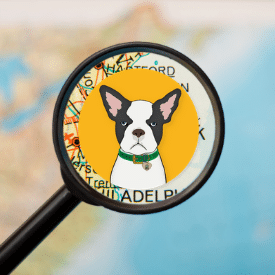Car Sickness in Dogs

Motion sickness, or car sickness in dogs, is relatively common. And, it’s more common in younger dogs than adult dogs. The reason is thought to be due to inner ear development. The inner ear plays a large role in motion and balance. Parts of the inner ear aren’t fully developed in puppies, but rather develop as the puppy ages. Puppies will often outgrow motion sickness at around one year old.
There are still cases where adult dogs may become nauseous or anxious during a car ride. That can be due to the lack of conditioning (lack of experience in a vehicle), trauma, or overwhelming stimuli (sounds, movement, sights). Dogs, for example, who travel only a few times per year to the veterinarian or groomer are more likely to experience car sickness than dogs who are known to go everywhere with their families.
Increased anxiety and stress may also result in car sickness in dogs. Helping resolve these issues can make their lives (and yours) much easier and allow you to spend more time together as a family.
Table of Contents
Symptoms of Car Sickness in Dogs
It’s easy for us to say “I don’t feel well,” but our dogs don’t exactly have that same option. Signs your dog may be experiencing motion sickness include:
- Whining
- Excessive drooling
- Pacing
- Excessive licking
- Vomiting
- Lethargy
- Diarrhea
If you notice any of these signs on your car ride, stopping momentarily to allow your dog to step on solid ground may reduce the symptoms associated with motion sickness.
Desensitization
Desensitizing your dog, or counter-conditioning may take some time. Some dogs are able to become accustomed to new experiences better than others. It may take one car ride for one dog whereas it will take months of car rides for others.
You should begin by taking short trips like a ride to the local grocery store. For dogs who are extremely fearful, you may even want to start by simply placing your dog in the car, turning the car on, and sitting for a few minutes while not going anywhere. Then, let her out, and try again the next day. Once she is comfortable with this part, you can try backing out and back into the driveway. It’s important to praise your dog during this process. This will allow her to feel safer and correlate car rides with positivity.
Once your dog is comfortable leaving the driveway, you can try your first trip to the store (if this isn’t where you started). Then, gradually increase the duration of the car ride. Being sure your emotions are in balance prior to attempting this feat is critical; she can feel when you are upset, nervous, happy, etc.
Additional Tips
There are a few additional tips we can discuss briefly including:
- Withholding food for a short period of time: If your dog is one who begins vomiting prior to a car ride, not providing significant amounts of food in the hours coming up to the car ride can be extremely helpful. An empty stomach may reduce the feelings of nausea while on the ride.
- Dog Safety Carrier: There are safety carriers available for dogs to sit in on car rides. Sometimes, this is all your dog needs to feel more comfortable.
- The smell of home: Dogs with anxiety often feel much better with something that smells like home. Home is their comfort. Bringing along a blanket or sweater that smells like their home can prove helpful.
CBD for Car Sickness in Dogs
There are several ways CBD can help car sickness in dogs. To start with, CBD interacts with the endocannabinoid system to promote homeostasis in the body and regulate nausea. A 2011 study published in the British Journal of Pharmacology stated, “Considerable evidence demonstrates that manipulation of the endocannabinoid system regulates nausea and vomiting in humans and other animals. The anti-emetic effect of cannabinoids has been shown across a wide variety of animals that are capable of vomiting in response to a toxic challenge.”
The American Cancer Society even includes cannabinoids on its list of ‘Medicines Used To Treat Nausea and Vomiting’. “These drugs may be used to treat nausea and vomiting from chemo when the usual anti-emetic drugs don’t work. They also may be used to stimulate appetite.”
For CBD for car sickness in dogs, we recommend our Calm tincture for dogs. This 550mg Full Spectrum CBD tincture is formulated with added Lavender essential oil, which has its own anti-nausea properties. CBD is also safe for dogs with sensitive stomachs. If you know your pet has a sensitive stomach, make sure to administer your CBD at mealtimes so it’s not the only thing in their stomach.
CBD can also help your pet’s anxiety and stress during car rides, as it’s been proven helpful with reducing feelings of anxiety. Reducing your dog’s anxiety both regarding the car ride and during the car ride can significantly help with their phobia. For dogs with past traumatic experiences, CBD can help reduce the feelings from past trauma and reduce your dog’s fears with car rides.
A recent study published in Frontiers in Veterinary science, showed a single dose of Cannabidiol (CBD) positively influences measures of stress in dogs during separation and car travel.
A 2024 article in the Journal of Animal Science showed daily dosing of cannabidiol (CBD) demonstrates a positive effect on measures of stress in dogs during repeated exposure to car travel.
Related: Traveling with Pets: Managing Anxiety
Final Thoughts
The bottom line is that there are natural options for dogs who experience motion sickness, and pet parents who worry that they’ll never be able to join on car rides again. It may take some work, some patience, and perhaps a little help from CBD to get them comfortable along the ride, but with the right help, it can be possible.















